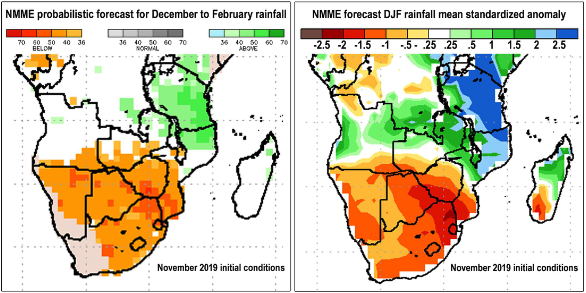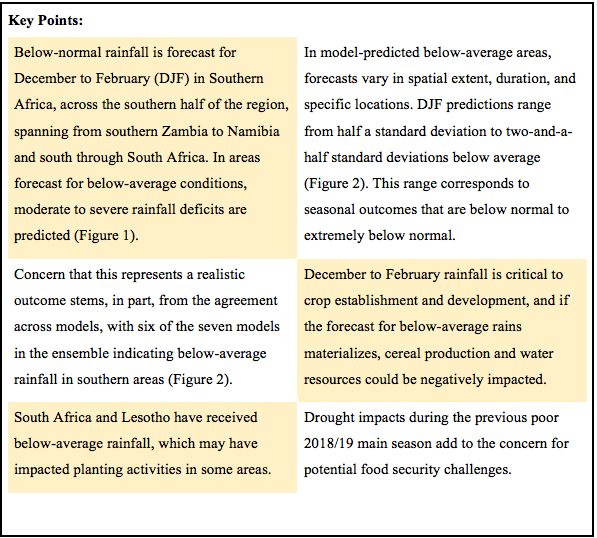CM4EW Special Report on Southern Africa
In a GEOGLAM Crop Monitor for Early Warning (CM4EW) Special Report released on November 18th, 2019, the University of California Santa Barbara’s Climate Hazard Center (CHC) helped broadcast an important message about the heightened risk of drought during Southern Africa’s 2019-2020 main cropping season. The latest set of forecasts from international models point to below-average rainfall for December to February, a key rainfall period for crop production. The report communicates the North American Multi-Model Ensemble forecast, potential food security outcomes, and the need for ongoing monitoring. Below are key points and more about CHC and the Crop Monitor. The CM4EW Special Report can be viewed here.

Figure 1. North American Multi Model Ensemble (NMME) rainfall forecast for December 2019 to February 2020, released in November 2019. The left image shows the probabilistic forecast. The right image shows the ensemble mean forecast standardized anomaly. In the probabilistic forecast, orange/red and green colors indicate the dominant tercile category (below-normal or above-normal) forecast by the NMME models, with the individual model forecasts judged according to their respective hindcasts. Color intensity shows corresponding probability of the forecast. Original images are from the NOAA Climate Prediction Center’s NMME webpage.


Figure 2. December 2019 to February 2020 rainfall forecasts from individual NMME models, released in November 2019. Values shown are standardized anomalies. Red to dark-red colors indicate below-normal to extremely below-normal forecast rainfall amounts compared to previous forecasts by that model. Dark-green to blue colors indicate above-normal to extremely above-normal forecast amounts. Original images are from the NOAA Climate Prediction Center’s NMME webpage.
This CM4EW Southern Africa Special Report was made possible through rapid collaboration between GEOGLAM CM4EW authors at the University of Maryland (UMD) and CHC scientists located at UCSB and in Southern Africa. CHC supports CM4EW through the communication of critical weather and climate forecasts in monthly bulletins. The Climate Hazards Center, in conjunction with FEWS NET and GEOGLAM partners, will continue to monitor the situation in Southern Africa as it unfolds, evaluating the latest observations and forecasts.
Communicating weather and climate forecasts through the GEOGLAM Crop Monitor
The collaborative relationship between GEOGLAM, NASA Harvest, CHC, FEWS NET, and other CM4EW partners (see UCSB CHC and the GEOGLAM Crop Monitor below) has helped foster a relatively new early warning resource for GEOGLAM CM4EW- regional climate outlooks. These are assessments of the latest forecasts for weather and seasonal climate that are designed to draw public attention to abnormal rainfall and temperature conditions that may impact food production or pose other risks to society. The outlooks are based on international and national forecast sources and recent observations, often focusing on food insecure regions. CHC also provides a brief climatic update on the current and forecast state of the El Niño-Southern Oscillation and other large-scale climate modes. Regional and global climate outlooks can be viewed here and are featured in monthly Crop Monitor for Early Warning and AMIS bulletins and in CM4EW special reports.
These forecast-related contributions to the Crop Monitor are led by Laura Harrison and Chris Funk at UCSB, in close cooperation with Christina Justice and Brian Barker at UMD. CHC team members prepare a number of data products, including CHIRPS rainfall data, CHIRPS-GEFS unbiased 5-to 15-day rainfall forecasts, CHC Early Estimates, and custom maps showing Subseasonal Experiment (SubX) 1-week to 4-week rainfall and temperature forecasts. FEWS NET/CHC field scientists provide key agroclimatic information for FEWS NET monitoring regions. The FEWS NET science team, which also includes partners at NASA GSFC Hydrological Sciences Laboratory, NOAA, and USGS EROS, provides support through state-of-the-science weather and climate forecasts, hydrological forecasts, and Earth observation data.
CM4EW regional outlooks alerted the global community to major recent droughts that developed in food insecure regions. Advance warning was given for East Africa’s March to May 2019 drought based on 1-month to several weeks ahead forecasts for April rainfall and early-in-the-season rainfall deficits. See the outlook published April 4th, 2019 and the strategy used for early drought identification in this Agrilinks article. In Southern Africa, below-average rainfall during the October 2018 to May 2019 main cropping season produced severe drought impacts in some areas. A CM4EW outlook, published in early December 2018, communicated a warning about the early-in-the-season rainfall deficits that had occurred, and the potential for below-average rainfall to continue. The latter was based on dynamical model forecasts (NMME, C3S, and Australia Bureau of Meteorology model systems) for an El Niño and historical occurrence of seasonal rainfall deficits during El Niño events.
On October 3rd, 2019 an outlook for East Africa communicated the potential for the above-average October to December rains that materialized and have greatly impacted the region. The outlook was based on dynamic model forecasts for strong positive Indian Ocean Dipole conditions and increased chances of wetter-than-normal conditions, a consensus forecast from experts in the region (Greater Horn of Africa Climate Outlook Forum), and the latest forecasts from multiple models for one-to-four-week rainfall. As can be seen in these cases, the regional outlook procedure involves a variety of forecast resources and observation-based data. CM4EW outlooks in the past year have tracked the development of multiple rainfall seasons across the world.
UCSB CHC and the GEOGLAM Crop Monitor
GEOGLAM Crop Monitor for AMIS and Early Warning bulletins are international consensus assessments of agro-climatic conditions in major global crop production and in food insecure areas. These agricultural monitoring bulletins are supported by existing initiatives at national, regional, and global levels and are coordinated by a team at the University of Maryland. GEOGLAM aims to strengthen these initiatives through international networking, operationally focused research, and data and method sharing. GEOGLAM’s origins lie in the global food price spikes of 2007/2008 and 2010, which led the 2011 G20 Heads of State to endorse the Global Agricultural GEO-monitoring Initiative (GEOGLAM). NASA Harvest, one of the many agencies that support Crop Monitor, describes GEOGLAM as a framework that strengthens the international community’s capacity to produce and disseminate relevant, timely, and accurate forecasts of agricultural production through the use of Earth Observations (EOs).
The Climate Hazards Center was formed with the primary goal of providing support to FEWS NET; as such, its work is frequently conducted under the guidance of FEWS NET, which also serves as a main partner to Crop Monitor. CHC contributes to NASA Harvest through three main activities: 1) development of short-term and seasonal forecasts of precipitation and potential evapotranspiration to integrate with EO data, 2) enhancing the capacity of partners and stakeholders in developing countries, and 3) the continued development of web-enabled tools to improve access to EO data sets. In addition, FEWS NET/CHC field scientists provide CM4EW with key agroclimatic information and engage in important consensus discussions. The CHC began providing regional and global climate outlooks for CM4EW and AMIS monthly bulletins and special reports beginning in September 2018. These outlooks help support early warning and advance public knowledge of the value of state-of-the-science weather and climate modeling.
November 27, 2019 - 10:55am

